I'm less interested in the visual ramifications, specifically whether 4 spokes or 6 spokes are able to be seen over the wall. I write it off as a psychological illusion...
Read this excerpt:
Read this excerpt:
The gravity issue, though, remains. We ALL agree that frame-dependent gravity would not occur, but it's fascinating to watch the discussion between Tach VS The World, where both sides claim the other "owns" the paradox, and is therefore wrong...I think it's safe to say that we all agree it wouldn't happen but no one can currently explain why.Penrose-Terrel Rotation said:...consider a train carriage that moves with constant speed along a straight track, past us who stand on the platform watching it. Light that leaves the back of the carriage will arrive at our eyes coincident with light from the side of the carriage; and as well, the carriage is Lorentz contracted. At first glance this seems to ensure that the carriage will look rotated, because we are used to seeing just such an effect from rotations in everyday (nonrelativistic) life. But clearly, on second glance, we will realise the carriage is not rotated, because we notice that its wheels are still attached to the track, which has not changed its aspect (since it's at rest relative to us). So there will be a psychological effect of the carriage looking somewhat rotated, but we will quickly notice that this is only an imperfect optical illusion.


